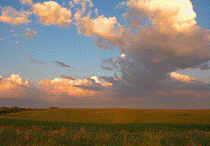North American Prairie Conference
Date of this Version
2004
Document Type
Article
Abstract
The relative abundance of grassland birds was estimated on an 81-ha (200-acre) dry to dry-mesic sand prairie in south, west Wisconsin over an 18-year period (1987-2004). Birds were surveyed three times during the breeding season on seven, 2-ha (5-acre) strip transects in six different burn units. We compared results to time since fire and other habitat features. The average rotation of prescribed fires in the burn units ranged from three to six years. Seven species were selected for detailed analysis. These were grasshopper sparrows (Ammodramus savannarum),-18-year average of 1.33 birds per ha, field sparrows (Spizella pusilla) at 0.64 birds/ha, eastern meadowlarks (Stumella magna) at 0.54 birds/ha, lark sparrows (Chondestes grammicus) at 0.50 birds/ha, mourning doves (Zenaida macroura) at 0.18 birds/ha, dickcissels (Spiza americana) at 0.17 birds/ha, and vesper sparrows (Poocetes gramineus) at 0.07 birds/ha. Observed bird densities by burn year indicated the year of burning to be unique in relation to other years in the burn cycle. Mourning doves and vesper and lark sparrows were detected in greater densities in the year of a burn compared to the years pre- or post- burn. In contrast, grasshopper sparrows, eastern meadowlarks, field sparrows, and dickcissels were observed at lower densities during the year of a burn than in the pre- or post-burn years, but they were never eliminated. For some species, such as lark, field and vesper sparrows, the removal of woody vegetation during the early years of the study period may have affected abundance. With the exception of vesper sparrows, overall management actions at Spring Green Preserve, including the prescribed burning regimen, appear to allow its grass land bird populations to be maintained.


Comments
Published in Dave Egan & John A. Harrington, editors, Proceedings of the 19th North American Prairie Conference: The Conservation Legacy Lives On..., University of Wisconsin-Madison, August 8-12, 2004 (Proceedings of the North American Prairie Conference, 19), Madison, WI: University of Wisconsin-Madison, 2004.